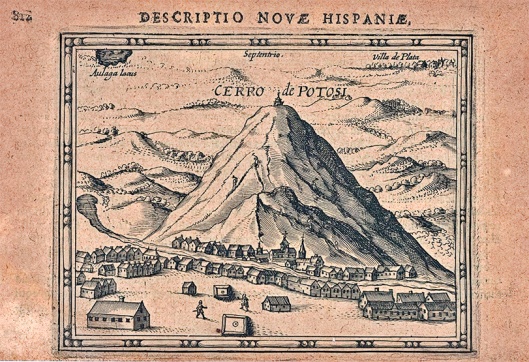Potosi, w XVII wieku srebrem płynące, było jednym z największych i najbogatszych miast na świecie. Niestety, cale owo srebro i inne cenne metale płynęły wprost do sakiew Korony Hiszpańskiej, aniżeli do kieszeni miejscowych czy afrykańskich niewolników, ginących setkami w kopalniach ‘Cerro Rico‘.
Ciekawostką jest to, iż nazwa miasta wywodzi się od słowa ‘potocsí‘, które w języku ajmara znaczy tyle co – grzmiący hałas lub od onomatopeicznego słowa keczua ‘potoq‘, które odtwarza dźwięk młota uderzającego o metal. Dźwięk ten do dziś zresztą słyszany jest w kopalniach ‘Bogatej Góry’. Mimo iż ikona ta wpisana została na listę Dziedzictwa Kulturowego UNESCO, grozi zawaleniem, co niestety mogłoby się przyczynić do całkowitego upadku legendy tego pięknego miasta…
Potosi, in the seventeeth century flowing with silver, was one of the largest and richest cities in the world. Unfortunately, the whole silver and other precious metals flowed directly to the Spanish crown, instead of the pockets of local and African slaves, hundreds of whom had died in the mines of ‘Cerro Rico‘.
Interestingly, the name of the town derives from the word ‘potocsí’, which in Aymara language means the same as – thunder noise, or from the onomatopoeic Quechua word ‘potoq’, which recreates the sound of the hammer striking the metal. The sound which is heard to this day in the mines of a ‘Rich Mountain’. Today, despite being protected as Cultural Heritage of UNESCO, the iconic hill is in danger of collapsing, what unfortunately could contribute towards the fall of the legend of this beautiful town…

‘Cerro Rico’, Potosi
Sława Potosi przeniknęła do literatury pięknej za sprawa Miguela Cervantesa, który w swoim wiekopomnym dziele Don Quijote de la Mancha (tom 2, rozdział LXXI) odniósł się do bogactwa miasta tymi słowy:
The fame of Potosi was immortalized in a literature by Miguel Cervantes, who in his memorable work ‘Don Quijote de la Mancha’ (Volume 2, Chapter LXXI) referred to the wealth of the city in these words:
Si yo te hubiera de pagar, Sancho ―respondió don Quijote―, conforme lo que merece la grandeza y calidad deste remedio, el tesoro de Venecia, las minas del Potosí fueran poco para pagarte (…)
Jeżeli miałbym tobie zapłacić, Sancho odpowiedział Quijote, jak znaczenie i charakter lekarstwa na to zasługuje, skarby Wenecji, kopalnie Potosi nie byłyby wystarczającą zapłatą (…)
If Sancho,” replied Don Quixote, “I were to requite thee as the importance and nature of the cure deserves, the treasures of Venice, the mines of Potosi, would be insufficient to pay thee.
W mowie potocznej ukuło się wiec powiedzenie, iż cos jest ‘vale un Potosi’, czyli ‘warte fortunne’.
The term ‘vale un Potosi’ found it’s way to common language meaning something ‘worth a fortune’.
7 listopada 1810 roku, argentyński oddział armii dowodzony przez Juana José Castelli, pokonał rojalistów w bitwie pod Suipacha, inspirując tym samym powstanie mieszkańców Potosi wszystkich klas społecznych przeciwko dominacji hiszpańskiej, które rozpoczęło się 10 listopada aresztowaniem hiszpańskiego gubernatora.
Z tej okazji każdego roku Potosi świętuje swój dzien. A ja tradycyjnie dedykuje wszystkim piosenkę. A jeżeli mówimy o Potosi, to nie możemy zapomnieć o TINKU – melodii i tańcu wywodzących się z pięknego regionu Potosi* (nie mylić z rytualem el Tinku). Mojego ulubionego! Posłuchajcie, zobaczcie, a zrozumiecie dlaczego:)
On November 7, 1810, Argentine army commanded by Juan José Castelli, defeated the royalists at the Battle of Suipacha, inspiring the inhabitants of Potosi of all social classes, to fight against the Spanish domination. The uprising had started on November 10, with arresting Spanish governor.
Traditionally, Potosi celebrates this day each year. On this occasion, I present you with the song. And if we talk about Potosi, then we can not forget about Tinku – the melody and dance derived from the beautiful region of Potosi* (not to be confused with the ritual of El Tinku). My favorite one! If you listen and watch carefully to T’una papita by Los Kjarkas, you will understand why:) —> Up!
Los Kjarkas – T’una Papita (Tinku)
* Tak, to właśnie w Departamencie Potosi znajdują się:
- pustynia solna Salar de Uyuni,
- kolorowe laguny,
- gejzery i skalne pustynie w Parku Narodowym Edvardo Avaroa ,
- Tupiza
- oraz Park Narodowy Torotoro.
Jak dla mnie, jest to najpiękniejszy i najciekawszy region Boliwii.
* Yes, precisely in the Department of Potosi are located:
- a salt desert Salar de Uyuni,
- colorful lagoons,
- geysers and rocky deserts of the National Park Edvardo Avaroa,
- ‘Wild West’ Tupiza or Torotoro National Park full of dinosaurus prints and fossils.
In my opinion, this is the most beautiful and the most interesting region of Bolivia.
P.S. Jeżeli chcielibyście dowiedzieć się więcej o dzisiejszym Potosi, zajrzyjcie do mojej zeszłorocznej relacji z wycieczki do jednego najwyżej położonych miast na świecie* —> KLIK.
P.S. If you wanna learn more about today’s city of Potosi read about my trip to the one of the highest cities in the world —> CLICK.











